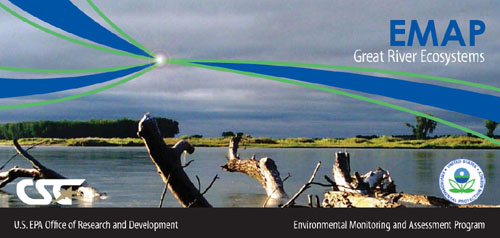Great Rivers Reference Condition Workshop
You will need Adobe Acrobat Reader to view some of the files on this page. See EPA's PDF page to learn more about PDF, and for a link to the free Acrobat Reader

Great River Ecosystems Field Operations Manual (227 pp, 12.8 Mb)
On January 10-11, 2006 a workshop on approaches to reference conditions for large and Great Rivers was held at the Hilton Hotel at Netherland Plaza in Cincinnati, OH. The meeting was co-hosted by EPA’s Environmental Monitoring and Assessment Program for Great River Ecosystems (EMAP-GRE) and the Council of State Governments. More than 100 scientists convened to hear and discuss 24 invited presentations on reference condition. Below is a link to the attendee list. The abstracts and presentations (as PDFs) can be accessed from links associated with the final agenda.
The organizers wish to thank everyone who attended the workshop.
For more information about the meeting or EMAP-GRE contact
Ted Angradi
(218) 529-5243
Angradi.theodore@epa.gov
Final Workshop Agenda
Attendees (4 pp, 90 Kb)
Tuesday, January 10
Welcoming Comments
Alan Vicory, ORSANCO Director
Mike McDonald, EMAP Director
Introduction to reference condition
Ted Angradi, EPA ORD: The Large and Great River “reference problem”: Surmounting the obstacles
Abstract (1 pp, 59 Kb)
Presentation (14 pp, 215 Kb)John Stoddard, EPA ORD: Setting expectations for the ecological condition of rivers: The concept of reference condition
Abstract (1 pp, 59 Kb)
Presentation (24 pp, 469 Kb)Mike DeLong, Winona State University: River ecosystem theory: Putting concepts into action by defining reference conditions for Great Rivers.
Abstract (1 pp, 61 Kb)
Presentation (28 pp, 1.8 Mb)Session Q&A
Approaches to Great River reference condition within existing Great River bioassessment programs
Erich Emery, ORSANCO: Reference condition in large regulated rivers: Will we know it when we see it?
Abstract (1 pp, 57 Kb)
Presentation (27 pp, 936 Kb)David Bolgrien, EPA ORD: Demonstrating a consistent and unified approach for monitoring and assessing ecological condition of the Missouri, Upper Mississippi, and Ohio Rivers
Abstract (1 pp, 58 Kb)
Presentation (15 pp, 727 Kb)Ted Angradi, EPA ORD: The EMAP-GRE approach to Great River reference conditions
Abstract (1 pp, 60 Kb)
Presentation (64 pp, 9.3 Mb)
Modeling and reconstructive approaches to reference
Yegang Wu, E2 Consulting: Models supporting a reference/desired future condition for eco-restoration of the Upper Mississippi River
Abstract (1 pp, 58 Kb)
Presentation (28 pp, 3.5 Mb)James Gore, University of South Florida: Assessing Florida's large rivers: GIS-based data mining and the impacts of the Atlantic Multi-decadal Oscillation
Abstract (1 pp, 58 Kb)
Presentation (49 pp, 3.1 Mb)Lucinda Johnson, University of Minnesota: Identifying reference sites in coastal areas of the Great Lakes
Abstract (1 pp, 57 Kb)
Presentation (48 pp, 12.9 Mb)Lester Yuan, EPA NCEA: Predictive models for bioassessment of large and Great Rivers
Abstract (1 pp, 57 Kb)
Presentation (19 pp, 462 Kb)Bob Hughes, Oregon State University, Using available historical data for developing reference condition
Abstract (1 pp, 57 Kb)
Presentation (36 pp, 4.1 Mb)
Perspectives on large and Great River reference
Ken Lubinski, USGS & The Nature Conservancy: Non-traditional concepts about large river reference conditions: Experience of the Upper Mississippi River
Abstract (1 pp, 59 Kb)
Presentation (22 pp, 1.2 Mb)Margaret Stewart, Water Environment Research Foundation: WERF explores research needs for large rivers
Abstract (1 pp, 59 Kb)
Presentation (22 pp, 477 Kb)
Wednesday, January 11
Indicator-specific examples
Jo Ellen Hinck, USGS BRD: Evaluation of reference conditions for fish contaminants and fish health indicators in the Great Rivers of the US.
Abstract (1 pp, 59 Kb)
Presentation (26 pp, 1.3 Mb)Paul Bukaveckas, Virginia Commonwealth University, Characterization of suspended particulate organic matter in rivers: Utility for monitoring and assessment.
Abstract (1 pp, 86 Kb)
Presentation (16 pp, 480 Kb)John Chick, Illinois Natural History Survey, Zooplankton indicators for Great River bioassessment
Abstract (1 pp, 59 Kb)
Presentation (29 pp, 1.1 Mb)Barry Poulton, USGS CERC: Approaches for developing theoretical reference conditions based on large river macroinvertebrate assemblages
Abstract (1 pp, 58 Kb)
Presentation (23 pp, 2.3 Mb)
State Programs
Bob Angelo, Kansas DHE: The Kansas perspective on large river bioassessment
Presentation (23 pp, 2.3 Mb)Mike Feist, Minnesota PCA: Minnesota’s large river monitoring program
Abstract (1 pp, 64 Kb)
Presentation (35 pp, 4.1 Mb)Tina Laidlaw, EPA Region 8: The Montana large river monitoring program
Abstract (1 pp, 57 Kb)
Presentation (36 pp, 1.9 Mb)Mike Beiser, Mississippi DEQ: The Mississippi Department of Environmental Quality’s non-wadeable stream bioassessment methods development program
Abstract (1 pp, 59 Kb)
Presentation (26 pp, 6 Mb)
Reference condition, biocriteria and the Clean Water Act
Andrew Casper, University of South Florida: Potential uncertainties in interpretation of Great River biocriteria: An example from the Kennebec River (Maine)
Abstract (1 pp, 61 Kb)
Presentation (17 pp, 686 Kb)Chris Yoder, Midwest Biodiversity Institute & Center for Applied Bioassessment and Biocriteria: The development and application of biological assessment tools and biocriteria for the assessment of impacts to aquatic assemblages in large non-wadeable streams
Abstract (1 pp, 61 Kb)
Presentation (64 pp, 8.1 Mb)Larry Shepard: EPA Region 7: Large Rivers and State Clean Water Act reporting responsibilities
Abstract (1 pp, 58 Kb)
Presentation (13 pp, 665 Kb)

![[logo] US EPA](../gif/logo_epaseal.gif)